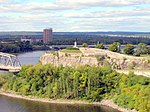Canadian Children's Museum
1989 establishments in CanadaCanadian Museum of History CorporationChildren's museums in CanadaMuseums established in 1989Museums in Gatineau ... and 2 more
National museums of CanadaUse Canadian English from March 2022

The Canadian Children's Museum (CCM) is a children's museum and exhibition operated by the Canadian Museum of History in Gatineau, Quebec, Canada. The CCM attracts about half a million visitors each year. It is also Canada's largest exhibition centre (3,000 m2 (32,000 sq ft)) designed specifically for children up to age 14 and their adult companions.
Excerpt from the Wikipedia article Canadian Children's Museum (License: CC BY-SA 3.0, Authors, Images).Canadian Children's Museum
Rue Laurier, Gatineau Hull
Geographical coordinates (GPS) Address Website Nearby Places Show on map
Geographical coordinates (GPS)
| Latitude | Longitude |
|---|---|
| N 45.429166666667 ° | E -75.708888888889 ° |
Address
Canadian Museum of History
Rue Laurier 100
K1A 0M8 Gatineau, Hull
Quebec, Canada
Open on Google Maps









